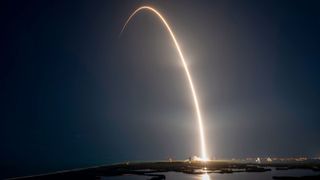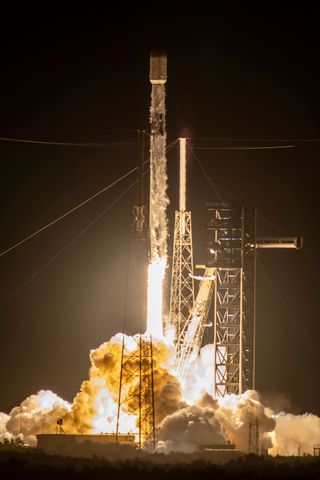
A timelapse exposure captures the streak from a SpaceX Falcon 9 rocket as it ascended from Cape Canaveral Space Force Station in Florida on Sunday, May 12, 2024.
(Image credit: SpaceX)
SpaceX launched 23 more of its Starlink satellites on Sunday (May 12), adding to its huge and ever-growing broadband megaconstellation.
A Falcon 9 rocket topped with the Starlink spacecraft lifted off from Florida’s Cape Canaveral Space Force Station at 8:53 p.m. EDT (0053 GMT on May 13).
Related: Starlink satellite train: How to see and track it in the night sky

A SpaceX Falcon 9 rocket carrying 23 Starlink satellites launches from Cape Canaveral Space Force Station in Florida on Sunday, May 12, 2024. (Image credit: SpaceX)
The Falcon 9’s first stage came back to Earth about 8 minutes after launch, touching down on the droneship A Shortfall of Gravitas, stationed in the Atlantic Ocean.
It was the 15th launch and landing for this particular first stage, according to a SpaceX mission description. Nine of its 14 liftoffs to date have been Starlink missions.
The Falcon 9’s upper stage, meanwhile, carried the 23 Starlink satellites to low Earth orbit (LEO), deploying them there about 65 minutes after liftoff.
Sunday’s launch was the 49th orbital mission of 2024 already for SpaceX. Thirty-three of this year’s 48 launches have been dedicated to building out the Starlink megaconstellation, which currently consists of about 5,900 working satellites.
Breaking space news, the latest updates on rocket launches, skywatching events and more!
That number will likely continue growing far into the future; SpaceX has permission to deploy 12,000 Starlink satellites in LEO and has applied for approval for another 30,000 on top of that.
Join our Space Forums to keep talking space on the latest missions, night sky and more! And if you have a news tip, correction or comment, let us know at: [email protected].
Michael Wall is a Senior Space Writer with Space.com and joined the team in 2010. He primarily covers exoplanets, spaceflight and military space, but has been known to dabble in the space art beat. His book about the search for alien life, “Out There,” was published on Nov. 13, 2018. Before becoming a science writer, Michael worked as a herpetologist and wildlife biologist. He has a Ph.D. in evolutionary biology from the University of Sydney, Australia, a bachelor’s degree from the University of Arizona, and a graduate certificate in science writing from the University of California, Santa Cruz. To find out what his latest project is, you can follow Michael on Twitter.
>>> Read full article>>>
Copyright for syndicated content belongs to the linked Source : Space.com – https://www.space.com/spacex-starlink-launch-group-6-58































